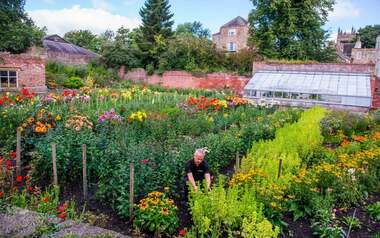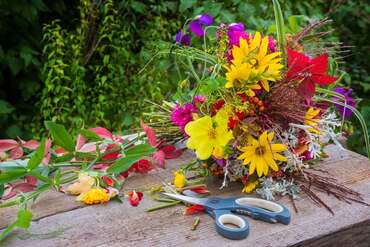|
My defunct and failing vegetable garden ravaged by groundhogs and rabbits was transformed into a cutting garden last summer. This year is my first season for cutting and enjoying armfuls of shasta daisies, coneflowers, hydrangeas, poker plants, scabiosa and roses. Stokes aster and dahlias are now opening and I look forward to the New England asters in the fall. I have copious amounts of flowers and enjoy filling mason jars for my home and friends. I am planning to catch some summer sales to add more plants like liatris and lavender. This blog shares my experience and advice for starting your own cutting garden. You don’t need a dedicated spot. Simply start by adding flowers to your existing beds, pots or your vegetable garden. Getting StartedWhen you’re designing a regular flower garden, you need to think about plants that look good together, will bloom in pleasing color combinations, and will thrive where you plant them. But the purpose of a cutting garden is different. It’s all about production, mix of colors and bloom times. For a cutting garden, there are five things you want to think about: 1. maximizing production 2. minimizing maintenance 3. growing flowers that will look great together in a vase 4. stem length 5. sequence of bloom Plant SelectionOne of the most important factors in a cutting garden is the availability of sun. Most cutting gardens require full to partial sun. In another blog we will address a shade cutting garden. The second most important factor in a cutting garden is stem length. Long-stemmed annuals, perennials and bulbs make the best cut flowers, so that’s where to start. Keep in mind that most plants have a specific bloom time, meaning they will not flower continuously. Spring bulbs, for example, bloom early and then fade away until next year. Early summer perennials such as peonies, iris, sweet William and lupines may bloom for up to a month, but then that’s it until the following year. Some perennials, such as scabiosa, shasta daisies, delphinium and coreopsis, will re-bloom if they are cut back after flowering. Annuals (and dahlias) have the longest flowering season. If you remove spent blossoms, they will usually give you a good 3 months of flowers. As you begin your planning, formulate a list of flowers you’d like to include based on: Color Fragrance Filler plants Attractive foliage Grow what you love To ensure a long season of color, create a chart like below. Use a computer, or good old colored pencils/markers to determine the color and bloom times of your plants and to plan for future purchases. Use a garden journal to track blooms and adjust plant additions. In the example, if you want more pinks or oranges, a different type of coreopsis could be used or rudebekia added. You can use this same planning strategy to achieve a variety of textures. By replacing the seasons with plant shape…round, spiky, trailer, foliage, you can evaluate the need for adding plants with a variety of shapes. Plan ahead for attractive combinations. If you have a relatively small space to work with, choose a color palette and then select flowers that will harmonize with those colors. Take a tip from floral designers and include a range of different flower sizes and shapes. Consider round flowers (ball dahlias), angular ones (foxgloves); soft ones (peonies) and stiffer forms (glads and salvia). Selecting a few stems of each flower shape results in a balanced arrangement. You’ll also want to include flowers that work as fillers and foliage (baby’s breath, ligularia, boxwood and hosta leaves). Foliage fills in the gaps of your bouquets, and will give your arrangements a professional touch. Cutting Garden FavoritesHere's a list of plants to get you started. It includes the most popular annuals, perennials, bulbs and foliage plants.
Maximize Production and PlanningGive your cutting garden a sunny spot with well-drained soil. Prepare the planting area, making sure it is loose and weed-less. If possible, take time to work in compost and all-purpose organic fertilizer. The most efficient way to set up a cutting garden is to grow your flowers in rows, as you would vegetables. In fact, growing a row or two of flowers in your vegetable garden is an easy way to get started. Creating a planting plan is the best way to maximize your growing space. Use a grid to make your plan. This makes it easy to determine how many plants can be squeezed into each row. Your finished planting grid can then be transferred to the garden.  Credit: Chris Watt for Durham's Telegraph. Allotment cutting Garden Credit: Chris Watt for Durham's Telegraph. Allotment cutting Garden When working out your planting plan, you need to know each plant’s mature height and width. Use the recommendations on plant descriptions and seed packets as a guide but reduce the spacing by about 30%. With experience, you’ll get a sense of which plants need a little more or a little less than the recommended amount of space. To make plant care (and picking) as easy as possible, it's best to plant blocks of the same type of plant, grouping like plants together. Plant perennials together, since they will stay in the same place from one year to the next. Plant annuals together so it's easy to remove them in the fall and replant in spring. You can also separate plants that need staking from those that need a fence or benefit from grow-through netting. Make room for paths so that you can access plants…18” to 2’ between rows is just enough to walk through rows. Never use landscaping fabric as it impedes soil health, reduces water absorption and doesn’t allow plants to spread. Minimize maintenance by adding stepping stones, mulch or grass clippings between plants and in paths. Mulching also helps to reduce evaporation and retain soil moisture. In a cutting garden, deadheading will be your primary maintenance task. Removing spent flowers encourages annuals and some perennials to continue producing buds. If you don't remove the dead flowers, plants assume they have fulfilled their mission and can shut down for the season. Another good reason to keep up with deadheading is plant health. As spent flowers begin to decay, they become a magnet for pests and diseases. A tidy cutting garden stays healthier, is easier to tend and looks better, too! Tips for Gathering Your Flowers From The Cutting GardenMixed bouquets are beautiful, but bouquets with all the same flower are beautiful too.
Did you know that arranging fresh cut flowers from the garden that has been practiced since 2500 B.C. by the Egyptians? Designing your own cutting garden is a sweet indulgence. We tend to concentrate on the flowers that we find whimsical, cheerful, beautiful, peaceful, and joyful. Cutting gardens encourage us to experiment with long-stemmed species we’ve never tried before. We stretch our creativity when we arrange our blooms in interesting containers. It is also a chance to appreciate the subtle nuances of texture, scent, and shape of every bloom and leaf. If you derive pleasure from bringing blooms into your home, follow our tips for a cutting garden. In one year, you’ll have plenty of flowers to place in your favorite container and an abundance of bouquets for yourself, friends and family. Comments are closed.
|
Thank you for finding us! Holly and I have collaborated to bring you informative, fun, and seasonal garden inspiration blogs.
Subscribe to receive our blogs on the 1st and 15th of the month--Gwen Follow my landscape & garden design Pinterest Page to see more pics, inspiration and Gwen's home garden journey!
AuthorsGwen Wisniewski: Landscape and Garden Designer. Contact me. Let me help you integrate these garden inspirations. Choose the links below to find out more about my landscape design service or to make an appointment. |














 RSS Feed
RSS Feed